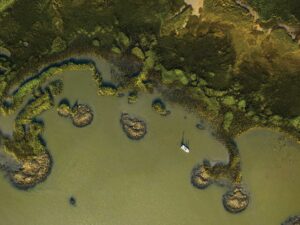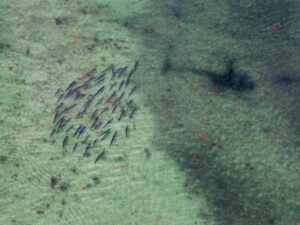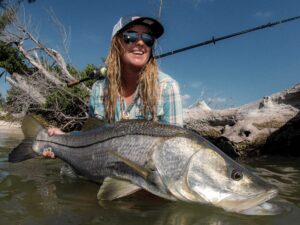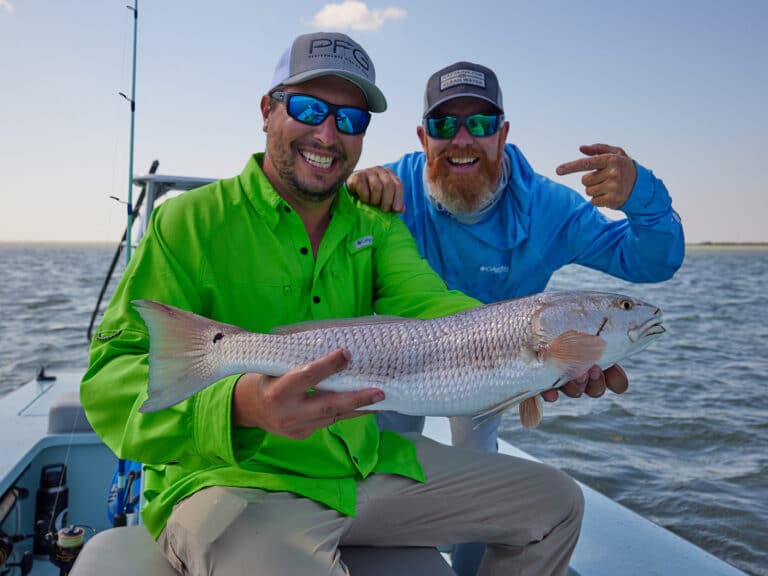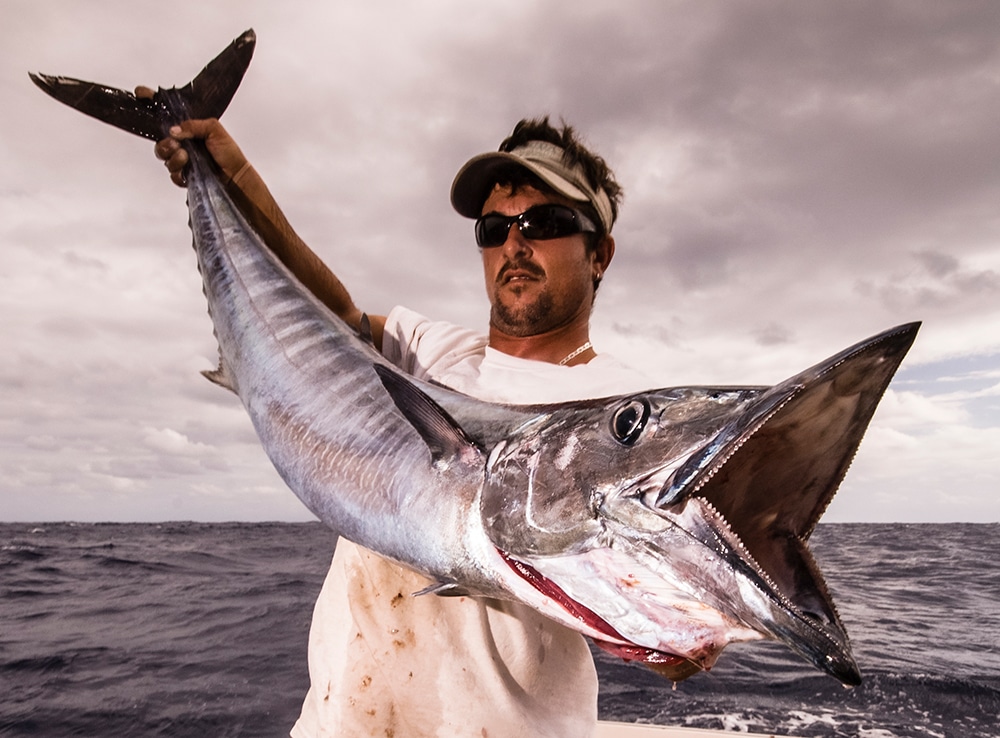
Negotiating the channels through the reef system off the southwestern shore of Bermuda isn’t for the faint of heart. The winding channel weaves its way through massive coral heads just beneath the surface, some only a foot or two outside the markers. There’s no room for error here, as many a careless skipper has discovered.
But the fishing you find once you get to the edge makes the harrowing trip worthwhile. The reef off the southwest edge drops off quickly, but then it rises again a few miles offshore on two of the area’s most famous seamounts: Challenger and Argus banks. This area of submerged reefs has strong currents that bring in both bait and predators in large numbers.
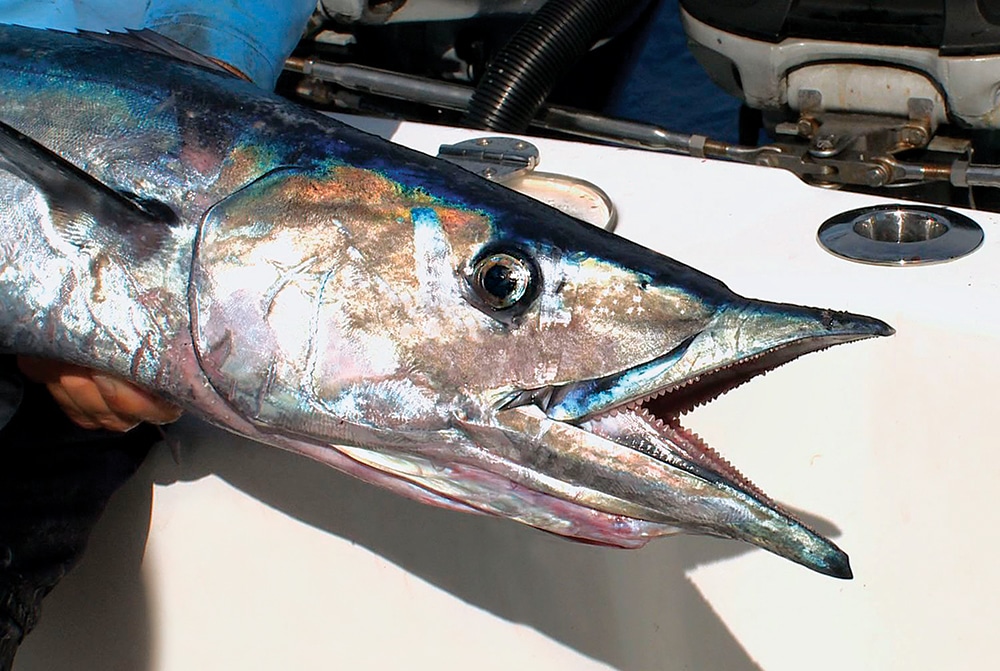
Fishing and Filming
We fished these fertile waters for wahoo last summer while filming an episode of Sport Fishing Television with Capt. Hamish Burns, a native Bermudian who generously agreed to serve as our host. Burns is a private recreational angler, but he and his son, Hamish Jr., are both experts at this game in their home waters.
After successfully traversing the reef, we began searching for live bait near a point of reef named Sally Tuckers. Although many methods exist to catch wahoo in Bermuda, live-baiting ranks as one of the best, and it’s certainly the most fun, especially when the strike comes at the surface.
Burns led us to a spot known to harbor “robins,” the local name for redtail scad, what we Floridians refer to as speedos. The two Burns men went to work chumming with handfuls of glass minnows (aka fry), and before long, schools of the elongated baitfish appeared beneath the boat, zooming frantically back and forth as is their habit.
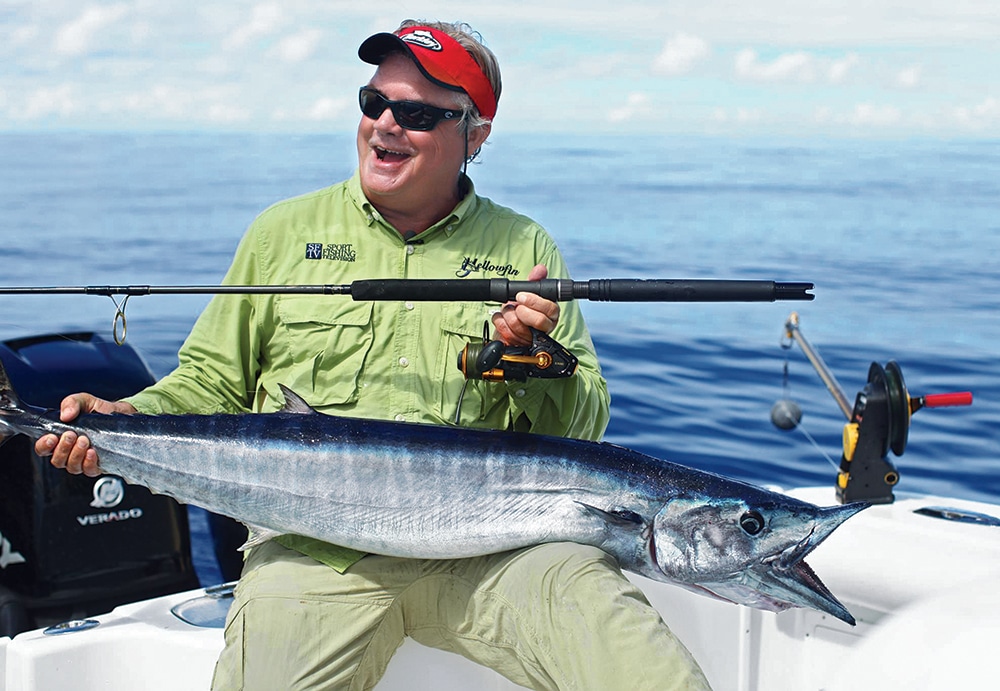
Filling the Well
Hand lines were soon deployed, and in no time, fellow angler Dan Jacobs and I had dehooked a dozen or more robins into the livewell, and Hamish Sr. announced it was time to fish. I assumed we would make a lengthy run to the fishing grounds, and was surprised when we motored only several hundred yards and began putting out the live baits.
Burns explained that the wahoo often swim tight to the reef along the drop-off, so we would start there. Never one to argue with local knowledge, I pitched in and helped set the spread. The robins were pinned to 6/0 circle hooks on wire leaders, side to side through their nose with a trailing stinger hook slid beneath the fish’s skin just in back of its dorsal fin.
Fishermen in Bermuda like downriggers, it would seem, since every boat I saw appeared to have one or more affixed to a covering board or the transom. We dropped a couple of baits down on Burns’ downriggers and left another bait swimming near the surface, in the hopes of maybe attracting the attention of a passing yellowfin tuna.
Fish On!
It didn’t take long for the deepest rod to go off. “Fish on!” Burns shouted, as Jacobs grabbed the rod and wound tight to the fish. It made a blistering run, then stopped and shook its head violently — classic wahoo behavior. Jacobs went to work on the fish, and we soon gaffed a brilliantly striped fish that would weigh close to 40 pounds.
My turn came next, and I hooked a mid-30s fish on a light spinning rod, an absolute blast. Over the course of that afternoon, we hooked and landed fish after fish, including several doubles. At one point, as Jacobs and I each fought a fish, he turned to me and said, “I told you Bermuda had the best wahoo fishing in the world.”
He got no argument from me.
Two Runs
Although there are always some fish around, Bermuda has two major wahoo runs, in spring and fall. In spring, the fish are headed north for summer, as far north as Georges Bank. In fall, they head back south to winter in the Bahamas and the Caribbean; the fall bite can be spectacular.
“In fall, it can go ballistic,” said Capt. Delvin Bean, who runs the 54-foot charter boat Paradise One, along with his brother Allan. The Beans like live bait too, but Delvin is quick to point out that “we use whatever it takes to produce fish.”
Bean says that in the spring run, the fish can be spread out around the entire island, and it’s a matter of locating them on a particular day. When searching for the fish, they often go “dinky trolling,” pulling small ballyhoo rigged on wire with single J-hooks and small skirts on downriggers.

Bigger in Fall
But in fall, live bait is preferred, and Bean says live baits usually produce bigger fish. “We fish out around Challenger and Argus banks with small, live mackerels (little tunny) in fall,” Bean says. “The fish average 40 pounds and up. One fall, we foul-hooked a fish out there, and we stopped the boat to gaff it. It was flat calm, and as the fish came up, I saw there were easily a thousand more wahoo with it. That’s how many fish we sometimes get here.”
When the bite is on, the locals say lure color on the troll doesn’t matter. “Everybody has their favorite,” said Capt. Sinclair Lambe of the charter boat Mega Bucks, “but when they’re biting, they’re biting, and they’ll eat whatever you put out there.”
Lambe says the fish spread out along the south shore in fall, and the southeast corner of the island can be good, as well as the southwest. “We like the live baits too, but we also like fast-trolling ballyhoos about 60 feet down on the downriggers,” he said. As for the spring bite, Lambe says the run has begun later in recent years. It used to start in April, but now it starts in mid- to late May.
The Southeast Corner
Speaking of the southeast corner, Capt. Peter Olander, who runs the charter boat Albatross with his brother Hans, spends most of his days there. Albatross is based at St. George’s on the east end, and is only 20 minutes from the drop.
“We fish close in to the edge, usually in 30 to 55 fathoms of water,” Olander said. “That’s where the fish are.” He will sometimes deploy live baits, but he typically opts for a more conventional trolling spread. “We use small flyingfish that we have flown in from Florida because our flyingfish are too large.” Olander explained. “We rig them on a pin rig with a chin weight just like a ballyhoo, and run two deep on outriggers with three flat-line baits.” He likes Ilander Junior lures in front of the fliers, but is not a fan of skirts.
Olander says Bermuda often gets a late-winter bite preceding the spring migration, but he also says the fish run somewhat smaller in spring. The bigger fish show up in fall, and he agrees that live baits will usually attract larger fish.
With Bermuda’s wahoo, you can choose your tactics (trolling or live-baiting), your time of year, even choose the tackle with which you engage them. I can’t think of any other place in the world that consistently offers as much incredible opportunity for one of the more interesting fish that swims.
Bermuda Wahoo Tackle Box
Tackle can be suited to choice. Many charter boats fish heavy gear, so you might wish to bring your own if you prefer lighter tackle.
Rods: Conventional trolling rods to 50-pound class, stout spinning rods designed for 20- to 30-pound-test.
Reels: Conventional reels to 50-pound class, large spinning reels with smooth drags capable of handling 20- to 30-pound mono or 30- to 50-pound braid.
Leaders/Terminal Tackle: No. 7 or larger stainless wire leaders with stinger rigs for live baits; pin rigs with chin weights for ballyhoo and flyingfish, rigged with J-hooks.
Baits: Live robins (redtail scad) or small mackerel (little tunny), or dead baits including small flyingfish or ballyhoo.
Bermuda Wahoo Planner
When: All year, but best in spring and fall.


